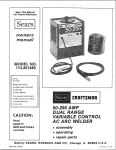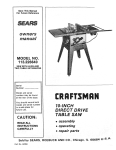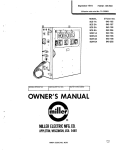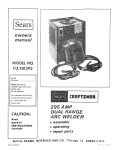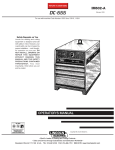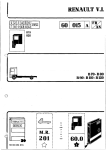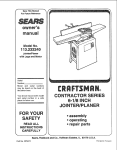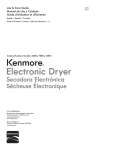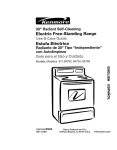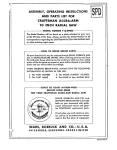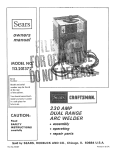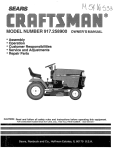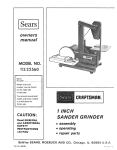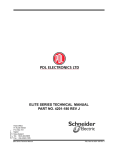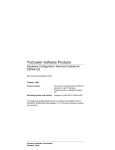Download Craftsman 113.201892 Specifications
Transcript
Save this Manual
For Future Reference
S_ AJRS
MODEL NO.
113.201892
Serial
Number
Model
and serial
number
at the
may be found
rear
of the cabinet.
You
should
model
record
both
and seriaI number
in a safe place for
future
use.
A C 230 AMP/DC
TRIPLE RANGE
ARC WELDER
CAUTION:
140 AMP
Read
® assembly
SAFETY
iNSTRUCTIONS
• operating
carefully
= repair
Sold
by
Part No. 61477
,i
SEARS,
ROEBUCK
AND
COl,
parts
Chicago,
i L 60684
U.S.A.
P_nted
_rl USA
....
-:%.
:.
': SAFETINST.UCT
IONS:TO:
: i Fail_re:i!t_:;:!f0i 0w these ::instructions
may result
in
sedods personat!njury_
:.
:::i;i:::
:
FIJME'S
ND G A S ES :iMAY B El :D AN G E ROU S TO
_O'U R :NEAETH::: ::: ,'
:i:'i
::iN:_iIjR E:::EYE S :A:ND :BEl RN S KIN.:
SH O
: ::::i::::
cooling
louvers in the welding cabinet. If these
objects contact
the internal parts of the welder
they couid damage the welder or result in an
electrically
hazardous
condition.
2. EYE AND
wEL:B:tNG SPARKS cAN: CAOSE_:E:XP_OSfON O R:
WORK
::-
AND
ELECTRODE
TABLE
Wear dry hole-free
ctothing:,::gtoves
and shoes
to protect and insulate tfie bodY.
b.-Fake special
care to insuiate "yourself
from
ground
using
dry insulation
{such
as dry_
wood) ol adequate
size when welding on meta_
floors:or
gratings,
and in positions
(such as
sitting 0r lying ) where parts or large areas of
y0ur:body
can be in contact
with possible
grounds.
c: Turn
sw_tch "OFF"
and remove
plug from
power source before picking upor moving the
wefdeL
d: Maintain
the:electrode
holder
work
clamp,
wetdin9
cable and welding
machine in good,
safe
operating
condition
by
practicing
periodic
inSpect.ion
and
preventative
maintenance;
.........
This
0se under ....
electricaiiy
hazardoi]S:c0nd
t _ns due to water
or perspiration
Under
these
conditions
automahc
control
equipment
_s required
in
accordance
with ANSI
Z-491
"SAFETY
IN
WELDING
AND CUTTING
"
f_ Connect
the welder
only
to a source
of
electrical
power
meeting
the requirements.
including
grounding,
of the National Electrical
Code (ANSI C1) and local codes.
Improper!y
wired extensfon
cords can cause a
potentially
fatal shock
hazard by electrically
energ z ng the welder
cabinet
Use only a
proper!y wired and adequately
sized extension
cord which
has a grounded
conductor
(See
'Connecting
the Welder to the Power Supply
elsewhere
in this
manual
for
more
information}
f you recewe a shock from the welder cabinetl
_mmediately
disconnect
the we_der from the
[_ower supply and obtain help from a qualified
electrician
g Do
not
drop
or insert
objects
through
PROTECTION
d. Protect
other
nearby personel
with suitable
non-flammable
screening.
e. Welding
can produce
fumes and gases which
are dangerous
to health. Keep your head out of
the fumes. Use enough ventilation,
exhaust at
the arc. or both. to keep fumes and gases from
your
breathing
zone and the general
area.
Take
even greater
care when welding
on
galvanized
or cadmium
plated steel and other
metals
which
produce
toxic
fumes.
Air-Supplied
helmets may be necessary.
" f. Protect
yourself
against
a fall should
you
receive
an electric
shock, particularly
when
working
above floor level. Keep floor around
your operating
position
free of clutter.
Never
wrap the electrode
cable around any part of
your body.
HOLDER
CLAMP
:WORK
PIECE
METAL
80 Volts exist between
these paris
when welder is 0n!
BODY
a. Use helmet
filter, and cover plate complying
with ANSI Z87.1 to protect your eyes and face
from
sparks
and the rays of the arc when
Welding
or observing
open arc welding.
b_ Always where safety goggles with side shields
complying
with ANSI Z87.1 when in a welding
area or when near a slag chipping
operation
c. Wear
oil free
flame
resistant
protechve
garments,
such as leather gloves, heavy long
sleeved shirt cufflesstrousers
and h pgh shoes
See picture of appropriate
dress=n "'Arc Weld _t
YOurself"
section of this manual
MRE:":
::
::
To pt0i_ectlyourself:
and others fforn these and othei _
hazard:s; read and 0bServe all instructions
included:
in tfiis rnanl_at asW_i!as!:the f01ibwing specific
safety
precautionS:_
!:
i :::::::!: !
1:
SHOCK
ai:
or live metal parts
0fi:the :electrode:holder
to touch bare skin Or
any ii:lara p::0(: wet i d6ve ring:of
the body. The
electri6dec0atiiig
Should be €0nsidered
as an
electrlCat COndu(_toiL Do not:insert electrode
in
electrode
holder with your:bare
hand
wear
proper gloves on both hands:.
ELECTRODE
OPERATOR
g Do not weld in locations
close to chlorinated
hydrocarbon
vapors coming from degreasmg.
cleaning,
or spraying
operations.
The heat of
the rays of the arc can react with solvent vapors
to form phosgene,
a highly toxic gas. and other
irritating
products.
h. Unprotected
spectators
must keep clear of the
welding
area due to the harmful
nature
of
ultra-violet
and infra-red
arc rays, welding
sparks, and welding
fumes and gases.
3. FIRE AND EXPLOSION
PREVENTION
a Remove
flammable
and explosive
material
at
least
35 feet from the welding
arc t,o prevent
welding sparks or molten metal from starting a
fire. Keep a type ABC fire extinguisher
within
easy reach.
b: Welding
on or near containers
which hold or
have
held
combustibles
can
cause
an
exDtos_on even when they have been cleaned.
Do not weld on such containers
until you have
read
"Recommended
Safe
Practices
for
Welding
and Cutting
Containers
and Pping
That Have Held Hazardous
Substances"
F4.1
available
from the American
Welding
Society,
550 LeJeune
Road Miami. FL 33135.
c. Vent hollow
castings
or containers
before
heating, cutting, or welding. They may explode
from
expansion
of trapped
air or boiling
liquids.
d. When not welding,
place the electrode
holder
where it is insulated from thework
clamp work
piece, or work table. Accidental
grounding
can
cause overheating
of the cables and welder,
creating
a fire hazard.
the
2
e. Neverconnectthe workcableor clamptoany
objectbut the work pieceor metalworktable_
Connectingto otherobjectssuchasbuilding
ground can cause stray currents to flow,
resultingin overheatingor fire.
4. PREVENTATIVE
Z49_!);_and "Fire Prevention
in Use of Cutting
and Welding
Processes"
(ANSI/NFPA
No.
51B) from the American
National
Standards
Institute,
t430
Broadway,
New
York,
New
York, 10018. Purchase copies of "OSHA Safety
and Health Standard"
29 CFR 1910 from the
U.S. Government
Printing Office, Washington,
D.C. 20402.
MAINTENANCE
'a. Never apply power to the welder with any part
of the "cabinet"
removed.
Position
on-off
switch in "off" position
and disconnect
welder
from
the
power
supply
before
doing
maintenance
work
inside
the
machine.
Removal of the welder cabinet should be done
only by a qualified
service technician.
b. Before
connecting
the welder power cord to
the receptacle,
check the following:
1. Inspect the power cord and welding cables
for cuts or burns and make sure blades and
ground
pin on the plug are straighL
2. Inspect "ON-OFF"
switch Iever for cracks or
broken parts.
3. inspect electrode
holder jaw insulators
for
cracks or broken parts.
c. Never
weld anything
on or to the welder
cabinet,
as a burn
through
may
cause
transformer
failu re.
d. If any part of your welder is malfunctioning
or
has been damaged
or broken, such as switch,
cables,
helmet,
electrode
holder,
cease
operation
immediately
and disconnect
welder
from the power source and turn switch "OFF"
until the particular
part is properly
repaired or
replaced.
5. ADDITIONAL
SAFETY
SPECmFgCATIONS
INPUT
Volts AC
.................................
Hertz (Cycles)
.............................
Rated Input Amps ..........................
Delay Action Type Circuit Breaker or Fuse
Short Circuit Amps
........................
Power Cord Length
........................
OUTPUT
AC Low Range Amps
..................
AC High Range Amps
..................
DC Range Amps
.......................
Arc Voltage
................................
AC Open Circuit Volts (max)
...............
DC Open Circuit Volts (max)
...............
Kilo-Volt-Amps
............................
Kilo-Watts
................................
Power Factor % ............................
Duty Cycle % ..........................
GENERAL
E_ectrode Capacity
..................
Low Hydrogen
.......................
Stainless
Steel .......................
Aluminum
...........................
Electrode
Cable Length
....................
Work Cable Length
........................
Dimensions
......................
INFORMATION
a. For additional
safety
information,
purchase
copies
of "Practice
for Occupational
and
Educational
Eye and Face Protection"
(ANS!
Z87.I), "Safety in Welding and Cutting"
(ANSI
READ AND OBSERVE
THE INSTRUCTIONS
APPEARING
ON THE WARNING
INFORMATION
FOUND
ON
THE
CABINET,
ELECTRODE
HOLDER
AND ON THE INSIDE
OF THE WELDING
HELMET,
TURNING
WELDER
WARNING
BE
ANO
SURE
THAT
I'HA_
ALL
ON.
CHECK
ARE
THE
NO
ELEC]ROOE
HOLDER
INSULATION
PROTRUDING
IS
,SCREW
TO
H_:ADS
SiECURE
8'
8'
t5 x 12 x 2t
a_d eye p_D_e_b0n
a,_ams_ _dun0u_ _y_ _0m ar_ we_dh1_erp!ale Impac_ _e_stantey_ p_9tect_o_!hll_ p_a_ ba_k-up p!atR o_
Separate _a!e_y _p_la_es_
should
Tes_sIant plple$
I
SHADEN0
LENS
ARC
WORK
WELDING
AREA _
CAN BE iNJURIOUS
CONSULT
OWNERS
To get the most from your welder
even if you're an accomplished
handy reference,
or in the event
FULL
ONE
YEAR WARRANTY
warranty
gives
you
specific
SEARS.
legal
ROEBUCK
rights,
AND
u_'_-
and _mmed_a_e_v
@
TO OPERATOI_
AND PERSONS
MANUAL
BEFORE
OPERATING
we suggest you read the manual carefully -welder,
and keep it available
to serve as a
that repair parts would be required.
ON
CRAFTSMAN
ELECTRIC
WELDER
If this Craftsman
Electric
Welder fails to perform
properly,
due to a delecI in material
or workmanship,
within one year
from the date of purchase,
Sears will repair it free o{ charge.
this warranly
applies only while this product
is in use in the
United States
WARRANTY
SERVICE
IS AVAILABLE
BY SIMPLY RE[URNING
THE WELDER
TO THE NEAREST
SEARS STORE
OR
SERVICE
CENTER
THROUGHOUT
THE UNITED
STATES.
This
t_0T
_-r_lechon-- ;_pface_mme_a_I¥
_s_ect _ouen_v
MADE f# _TALY
WARNING!
IN THE
_
br_akPbi_ P_'t$_0 rsc_'alched
pla_e_
E_ECTR,C
SHOCKCANBEfATAl'BEfORE
I
THERE
1/!6_3/16
!/!6-1/8
1/!6-1/8
3/32-1/8
0rdy for!a_
Impact
..,_
35-140
50-230
30-140
25
74
80
t2
7.2
60
20-100
CAUTIg_
U_
'I
I
230
60
50
50Amp
67
6'
and you
CO,.
may
Dept.
3
also
have
698/731A.
other
Sears
rights
Tower.
which
vary from
IL 60684
state
to state.
"_
-TABLE
:i-....... ,,:.
OF CONTENTS
::2
Operating:
Coriti;o s: .,.
Troube:Sh0oting:i:i.:::.:
Warrantv
_...............
:
.....
'::i_:::::. ,...:..........
::.i i:::i !:::. 4
6
8
.........
REPAIR
AND CHECKING
PARTS
:...
::.:i:i i, .....
2-1
.....
2-6
CONTENTS
ELECTRODE
DIAMETER GAUGES
OUTLET
ON-OFF
WORK
JACKS
CABLE
;K
DO OUTLET4
WELDING
HELMET
/
/
WORK
CABLE
WORK
CLAM
AND
P
WARNING:
FOR YOUR OWN
PLUG WELDER
IN IF PARTS
DAMAGED.
SAFETY,
DO NOT
ARE MISSING
OR
Key_
.
N0. PartName
Qty
,,,
SET-UP
INSTRUCTIONS
This Craftsman
welder.is
shipped complete
in one
carton:
in :order:;_to facilitate
packaging,
certain
itemslmust:i
be assembled
when received by the
purchaSei;:2BemoVe
afl items.from
the carton and
.
ident fy item
: as :;shOwn
in::,:the! e:,x,ptOded::!iview _
iilUSt:ration:
These :: "Loose
i Parts" :sho:ul:d i:_!:
be _-_:
accounted
for before discarding:
any packag
rig: ....
material.
ASSEMBLY
TOOLS
NEEDED
7/16-inch
wrench
Screwdriver
(medium)
ATTACHING
ELECTRODE
HOLDER
TO ELECTRODE
CABLE
1. Locate the slotted head, handle locking screw
near the front of the insulating handle. Remove
this screw.
Z Slide the handleoff electrode holder and insert
end of electrode cable assembly through the
handle: The electrode cable is the one with
insulation stripped from one end.
3. Prepare=the end of the cable by splitting the
strands into two equal bundles. Bend the bundles
into a forked shape and twist together to prevent
fraying.
=
._
1 Welding HElmet:(Partially assembled)
1
2 Helmet band assembly (Not Assembled) .. .... .......
1
3 Electrode cable assembly ..............
. ::: ..... :....
1
4 Work cable assembly , ....................
.,.,:..,
t
5 Loose Parts Bag -- Coetainingt;qefollowing items: ...
1
Electrode Holder ..... . .... : ...... :...:,
1
Work Clamp ........ ..............
..:..:........ .
1
Screw Hex Hd. 1/4-20x 3/4in..:;.....:,:,._,...:..
!
/
NuL Hex. !14-20 ::,.....
....... .-..::,.,,i.....
....
Washer: Flat 17164in............
:. .... ...:..,....,
_ 1
L0ckwasher, 1t4 in.........................
!
4. Back out the slotted-head
screwtocated
near the
end of the electrode
holder until the cable end can
be placed under the rectangular
clamp plate.
5. Insert the end of the cable under the clamp plate
so that the forked end of the cable passes on each
side of the screw.
6. Tighten
the slotted
head
screw
very firmly.
7. Slide the handle back into place on electrode
holder and position it until the hole in handle is
directly over the handle locking screw hole. Install
the handle locking screw and tighten.
SCREW
ATTACHING
TO
THE
THE WORK
CLAMP
WORK
CABLE
1. Attach the terminal
on end of work cable to the
work clamp, at the ho_e near the nose of the
clamp with the 1/4-20 x 3/4-inch
screw, 1/4-20
nut,
17/64-inch
flat
washer
and
1/4-inch
tockwasher
furnished
in the loose: parts bag.
2. Do not use either
work clamp.
CONNECTING
of the holes
WELDER
in handle
TO POWER
3. Tighten
contact
slipping
ends of
SUPPLY
the screw firmly enough
and prevent
the cable
on the clamp.
GREEN
CoP_nect
$ingte
(Inc.
Extension
in
!:o hot
phase
',vires
system
of
a
only,
FUSES OR C{F{CUtT BnEAKERS
amps at 20% duty cycle in accordance
with
Article
630 of the National
Electrical
Code
(ANSI Ct) and may not be adequate
for other
loads. Consult
a qualified
electrician
before
using for other loads.
,
Connect
230-volt
shown in figure.
power
lines
3. Install 50 ampere circuit breakers
delay
action
type
such
as
"Fusetat",
Cords)
Up to 30 feet ..........
No. !0 AWG
30 to 50 feet
...........
No. 8 AWG
Over 50 feet ............
No. 6 AWG
NOTE -- These conductor
sizes are for
a welder having a rated input not more
buss
ECEPTACLE
Electrical
connections
between
the welder
and
grounded
230-volt,
single-phase,
60-cycfe
a-c
power
source
should
be made
by a qualified
electrician.
All wiring must comply with the National
Electrical
Code (ANSl/NFPA70)
and local codes.
1. Install
an individual
(separate)
line for the
welder with delayed action_ type circuit
breaker
or fuses in the line. For best results, this circuit
should be as short as possible.
The size of the
supply
conductors
wilt depend
upon
their
length as shown in the table below.
Conductor
good
from
W{RE
Con_ecl
Io g_ound
power
panel.
CAUTION:
To avoid damage to unit, fire or electrical
hazards, do not attempt to connect this welder to a
regular household outlet. Make sure the power-line
voltage and frequency agree with the ratings shown
on the cabinet.
Supply
to insure
terminal
Copper
Copper
Copper
use with
than 60
4.
5
and
ground
as
or fuses of the
"Fustron"
or
Use
Sears
Cat.
#20691
Power
Receptacle
available
through
most Sears Retail or Cata}og
outlets or any certified
50 amp, 250 volt. 2 pole, 3
wire, grounding
type receptacle.
ii:!:i::i:_:i
== v
!::O
JNTRO:L:S
@
welder: is derived from
is equipped with
ranges two :AC ranges and
our
::tt
j
P
one
suitable for electrodes
The 50-230amp AC range requi_:es less line (input
current) draw for any given amp setting and permits
SELECTING
DC RANGES
Your new arc welder has a DC range which makes it
possible for youto weld aluminum using al uminum
welding rods. You will find this increasing_.y useful
as aluminum
is be ngused
eXtensively
today,
mostly because o_ its light weight,: corrosion
resistance, and its ability to conduct heat.
The DC range is also preferred for verticat and
overhead welding, for welding thin metals, for
reducing pop-outs; with many difficult to use rods,
and to reduce
important.
CONNECTING
ELECTRODE
AND WORK
CABLES FORAC
WELDING
Insert the tapered plug on the: end of the electrode
cable into theproper
Outlet jack depending on
range required, insert the tapered plug on the end of
the:work cable into_the AC work jack.
:To insure a good electrical connection always twist
the: electrode
plug _slightty: while inserting.
To
rem0ve the plug twist in theopposite directi on while
remowng:
NOTE:: If_you extend the welding:iilCables:beyond
those already supplied, they:must be No: 4 AWG or
larger to avoid an undue drop:in:weiding:currenL
DO NOT EXTEND CABLES OVER 50 FEET.
Connect the work c amp to the: piece to be welded,
(to complete the etectdcai circuit) or to the weiding
table itself provided it is metailic orwill conductl
electricity!
CONNECTING
CABLES
up to 3/!6 inch diameter.
Either range may be used, depending on operator
preferences when the electrode diameter permits.
ELECTRODE
AND WORK
FOR DC WELDING
Polarity: In DC welding it is possible to change the
direction of electron flow. This is done by changing
the manner in which the electrode cable and the
workcable are plugged into the DC jacks.
ForDC
Reverse Polarity: The electrode cable is
plugged into the positive DC jack and the work
cable is plugged into the negative DC jack._ In this
mode the electron flow wilt be from the wo_rk to the
electrode. This mode may be used for ahJminum
welding, weldi ng .on thi n sheet metal, cast iron a nd
high carbon steel. This is also the best mode for
overhead and vertical welding.
WORK
CABLE
l
6
spatter
where
appearance
is
For DC Straight Polarity: The electrode
cable is:
plugged
into the negative
DC jack and the work
cable is plugged
into the positive
DC jack. In this
mode the electron flowwill
be from the electrode
to
the work. This mode is used for hardsurfacing,
mild
steel welding,
cutting
and burning
holes.
For more
polarity
the table
provided
Welds
Aluminum
ELECTRODE
C
detailed information
regarding
the current
to use with specific
welding
rods, refer to
provided
on the welder and to information
with welding
rods.
@
Connect
the work clamp to the piece to be welded,
(to complete
the electrical
circuit)
orto the welding
table itself provided
it is metallic
or will conduct
electricity.
We feel that welding with your new Craftsman
range arc welder is as simple as A.B.C.
140ou,.u,
DC
_/ORK
CABLE
o
dual
A. Determine
what diameter
electrode
should
be
used by gauging
the piece to be welded on the
material
thickness
gauge.
The
fractional
number directly
beneath the bar chart dictates
what the proper electrode
diameter
is for given
thicknesses
of metals,
You will note that a
specific
diameter
of electrodes
can be used on
varying
thicknesses
of
material.
This
is
accomplished
by adjusting
the heat selector, for
more or tess amperage.
B, Next verify the electrode
diameter,
by placing
the bare portion
of the electrode
against
the
electrode
diameter gauge located under the bar
chart.
Because
electrodes
may be small burrs
electrode.
Make sure
as clean as possible
are mass produced,
there
on the bare ends of the
the bare end of the rod is
for accurate
sizing.
f
C. Finally, determine
the type of electrode
by the
identification
on the
package
or by the
American
Welding
Society
number
stencilled
on the coated portion
of the electrode,
bearing
in mind the type of electrode
you have chosen -E6013 or E7014 or aluminum
and also its'
diameter
(as previously
determined).
/
Locate
the electrode
size and type in the
recommended
amperage
range table below the
welding
rod gauge, and read the recommended
amperage
setting,
Where the electrode
can be
used on either AC or DC, both recommended
settings
are given,
7
: i/:
..:Now !oosen tlie heat selector knob and move the
pointer
urtti/_i_ecommehded
Setting: appears_:: i n
thep0i
::i _i:!:
.:::i:
,:i i: :
:'
.nob:
::
:
::
i: i
selected)::_ Connect.the
Work Clam p to the w6rk
Wear
Turn:the
• lower your:Welding:
to:weld,:-
.
'ON"
position,
He!meL, and you are ready
....
up and the
technique
of each operator
fsdifferent,
you may
find it necessary
to increase
or decrease
the
amperage
setting; accordingly.
CAUTION:
Donot
loosen and move amp selector
while welding.
The duty cycle scales: bracketing
the amperage
scales
are provided
for :your
convenience
and
protection
ofly0ur
new welder.
Duty cycle is the
performance
level of the welder
based
on a t0
TROUBLE
!
SHOOTmNG
WARNING:
TROUBLE
i
Removal of the welder cabinet
a qualified service technician.
top for any reason
TROUBLE
CHART
: ::: i
Fan and welder do:i
: not operate, or :-:: ....... i
: Continually
blow
_ :i I
:fuses:
minute
time span,
For example
welding
for 6
minutes oul of 10 minutes is a 60% duty cycle. To
avoid
possible
overheating
of the
welding
transformer,
which
could shorten
the fife of your
welder, Do Not exceed the duty cycles indicated
on
the duty cycle scales.
:
PROBABLE
Improperly
_P r otected,
112. Blown
fuse,
SHOOTING
CAUSE
fused
!
or
Welding
:::
currentlow
or open
or weak
Low
:
Can't hold an arc.
iti:,111 Haven
"
2, Welding
Cur:rent
Setting
too low.
3, Poor
"
,
:
i:!
!
connections:
.:_L_ _
by
REMEDY
or reset the
circuit
"On".
voltage
:
check
performed
the local power company,
2. Check Current recommended
the electrode
being used.
3, Check electrode
holder, work
electrode
cable connections.
Using a D.C. welding
rod on A,C, range.
2. Using
rod,
fuse,
3: Turn:switch
line v01tage_
!
SUGGESTED
2, Replace
breaker,
i:i;;;OmOif:" " :switch
t
be done
1 Use 50 ampere fuses of the delayed
achon type such as " Fuse tr o n" o r Fustat
or 50 ampere 240 volt circuit
breaker.
....
:
must
low hydrogen
3. Improper
polarity on
D.C. range,
SERVICE
1. Use AC or AC-DC
by
for
and
rods,
2. Use rod of 1/8-inch
maximum
diameter,
or smaller on 30-140 amp A.C. range or
use D.C. range with reverse polarity.
3, Check that cables are plugged
into the
correct
jacks to give polarity
per the
recommended
amp range table.
TIPS
FAN MOTOR
No provision
has been made for lubricating
motor,
as extra
large
oil
reservoirs
lubrication
for the life of the motor,
the fan
provide
:
f
A COMPREHENSIVE
GUIDE FOR YOUR
NEW CRAFTSMAN
ARC WELDER AND
WHAT iT WiLL DO
CONTAINS:
INFORMATION
= VARIOUS
= USEFUL
ABOUT
TYPES OF RODS
ACCESSORIES
° TIPS ON CUTTING,
AND BRAZING
WELDING
J
Form
No. SP574_5
14
•ii:i•I;••
••
TABLE
OF
CONTENTS
Page
YourWelderandWhat It Will Do .............
1-3
Howthe CraftsmanContactRod SimplifiesWelding 1-3
WhatHappensWhenYou Weld? ..............
1-3
ReadBeforeWelding ......................
14
LearnBy Doing............................
1-5
PositionWelding .........................
1-11
Cast-IronWelding ........................
1-14
HardSurfacingWore CuttingEdges ..........
1-15
TheTwin CarbonArc Torch ...............
1-16
Cuttingand OtherMiscellaneousOperations .,.
1-17
Read this Manual carefully
for additional
SEARS,' ROEBUCK AND COMPANY
AND SIMPSONS-SEARS
LIMITED
1-2
welding
information.
YOUR
WELDER
and what it will do..,
Your CRAFTSMAN Arc Welder is a sturdily constructed and thoroughly tested machine engineered to
give many years of efficient trouble-free service. It is listed by Underwriters' Laboratories,
incorporated, which means that it passesall requirements of safety, fire hazard and temperature rise
limits asspecified in their Standard for Transfer-Type Arc-Welding Equipment.
HOW THE CRAFTSMAN ELECTRODE
SIMPLIFIES WELDING
Craftsman
restarting...
Contact
Electrode is self-starting-plus
The electrode starts on contact.
automatic
Craftsman Contact Electrode is self-cleaning ... Under normal
conditions the slag removes itself asthe weld cools. Spatter is almost
non-existent. Craftsman Contact Electrode has an exceptionally
good appearance ..,
With fine ripple, unusually clean, smooth
appearance, and reduced slag inclusions,
Craftsman Contact Electrode deposits more metal faster,,.
the powdered iron in the flux goes into the weld.
W' H AT
H A P P E N S
WHEN
YOU
Because
WELD?
Arc Welding is the process of fusing two or more pieces of
metal together to form one piece. It is accomplished by
heating adjacent metal surfaces to the melting point with an
electric arc, then adding a sufficient amount of molten
metal to provide reinforcement and fill any vacant space
between the parts being ioined, as shown in the accompanying illustrations.
The arc is created when an electric current, regulated by
a welding transformer, flows across an air gap between an
electrode and the work being we_ded. The intense heat
generated by the arc is ic{eally suited for welding, as it
can be directed to affect only the part of the metal to be
welded. Uniform heat from the arc, is acquired by keeping
its length the same for a given rod size and current setting.
At the instant an arc is "struck", a portion of the base
metal directly beneath it, is melted, resulting in a small
poot of molten metal, some of which is forced out by the
blast of the arc and deposited along the weld path. The
depth of the crater thus formed, is the distance the weld
wit[ extend into the base metal and is referred to as the
penetration of the weld.
|
Seth edges of the metal
are heated by the arc,
until-
more molten metal and
flux is added from the
rod, which 5
2
4
they meft and flew together forming one piece,
instantly--
fills the crater and covers
the top of the weld with
slag.
This process continues the entire length of the weld.
Some of the electrode (which consists of a metal rod surrounded by a flux coating) is melted simultaneously with
the base metal and is carried by the arc to the liquid pool.
This added metal combines with t_e base metal to form
the deposited weld.
During this operation a part of the flux coating burns off
and forms a gaseous smoke screen that completely envelops the arc, protecting the molten metal from harmful
effects of oxygen and nitrogen in the surrounding atmosphere. The remainder of the flux coating that melts is
carriec_ to the molten pool where it mixes with the metal
to combine with various impurities. It then floats to the
surfaces to form a coating of slag which covers the deposited weld metal, protecting it from the atmosphere and
retarding its cooling.
When operating
a welder, certain
precautions
must be
taken to prevent injuries to yourself and others. Knowing
how to use the protective
equipment
to safeguard
against
them is the first step in learning
to weld.
:The effects Of heat and light given off by the arc, while
electric We ding, may be corollated t0 that of the S_Jh;S
r:_ys.
Even greater precautions are necessary for electric arc
welding. Before starting a weld, caution anyone in the
immediate vicinity against looking at the arc, In case of
accidental eYe injury, contact a physician immediately.
Animals are also affected by the rays and should be kept at
asafe distance.
To protect the face and eyes a heat-resisting; fiber:glass
helmet is used, The special fens, which allows the user to
View the arc safely, is inserted into the framed opening of
the helmet, The clear glass,which should be replaced from
time to time, protects the expensive special lens from
breakage and weld spatter. The helmet is held firmly in
place on the head with an adjustable head band, thereby
leaving both hands free. A close-fitting skull cap should be
worn with the helmet. As the helmet is used only when
actually welding, a tilting arrangement permits it to be
swung up clear of the face. When the welding is resumed a
slight nod of the head tips the helmet down over the face.
To protect the eyes further while cleaning the weld, goggles
should be worn by the welder and others working around
him.
To safeguard the hands against heat and weld spatter,
gauntlet-type
leather gloves should be worn. A leather
jacket or apron will give better protection
against the
_hower of sparks than ordinary clothing. High top shoes
(not oXfords) should be worn. If a great deal of welding
tobe done, foundrymen's
shoes are best.
is
Precautions
must als0 be taken to protect property
and
equipment
against fire. A large fire extinguisher should be
wlthin easy reach. The welding area should have a concrete
or cinder floor, kept dry and clear of inflammable
rubbish.
Sometimes,
it is necessary to weld dose to €: fuel tank. If
practical,
remove the part to be welded. If not, drain the
tank
and
completely
fill
Few tools, in addition
machine,
are needed
the average
shop.
it with water.
to those supplied with the welding
and most of them can be found in
Two sawhorses
supporting
a 1/4-inch
steel plate makes an excellent welding table. A permanent
bench, using the same steel plate, can be made of angle
iron or pipe. A chipping
hammer is used to clean slag off
a weld and pliers will be useful for handling
hot metal. A
wire brush is used to clean the work before welding and
remove
small
pieces
of slag after
chipping.
Small pieces of mild-steel scrap iron, reasonobly free of
rust and paint, should be used for practice welding. Angle
iron, bar stock or plate steel are good examples. Do not
use scrap cast iron, high carbon or hardened steel as these
metals require special electrodes and welding techniques.
These should be set aside for future practice after completing elementary practice lessons.
LEARN
BY E:)O NG
OFWELD
DIRECTION
Experience has proven that short periods of practice at
regular intervals are the best way to teach yourself how
to weld. As learning to weld is simply a process of trial
and error, all practice work should be done on scrap metal
that can be discarded. Do not attempt to make repairs on
valuable equipment until you have satisfied yourself that
your practice welds are of good appearance and free of
slag or gas inclusions. Remember, what you fail to learn
while practicing, must be learned through a series of
mistakes and rewelds later on.
A comfortable body position is important when learning,
as tensed muscles will result in fatigue and Jack of control.
Sit on a low stool and grasp the electrode holder in one
hand with the cable drawn across the }ap. Allow enough
slack to move the holder freely and yet keep the weight
and drag of a long length of cable from becoming tiring.
The work
connection
circuit
as the cable
is as much
and electrode
Any method of bringing the tip of the rod in contact with
the work, then quickly raising it until there is approximately
a I/8qnch gap between the rod and the work, will start an
arc. The easiest way for a beginner to strike an arc is to
scratch the tip of the rod a short distance on the surface of
the work, as you would a match, then lift it (qu;ckly) the required 1/8-inch (fig. !). Another method is to strike the work
a hard blow with the tip of the rod and allow it to bounce
u_ to form the arc gap. The important thing is to strike
the arc quickly and not allow the rod to remain in contact
Mth the work.
a part of the welding
holder.
A poor work
connection
can
render
the
best wetding
equipment
inefficient.
When using a table with a steel top, fasten the
lug of the work cable to it securely with a bolt or C-clamp,
so that any piece of iron placed on the table top wilt be
properly
grounded,
work cable directly
first
attempting
to weld. Insert a small, mild-steel
welding
electrode
in the electrode
holder
and connect the welding
cables to produce
the heat specified
by the CONTROL
panel. Connect
the ground cable to the work and set the
indicator
in the
current
range
recommended
for
the
diameter of rod used.
tf a steel table is not used, connect the
to the work with a work clamp or belt.
Select a fairly large piece of steel plate approximately
1/4-inch thick and clamp it to the table top to prevent it
from tiffing, should the electrode stick or "freeze" when
A common
mis{ake
often made by a beginner
is to point
the rod toward
the work an.d, after lowering
the helmet,
feet slowly about until the tip of the rod touches the work.
This always results in sticking
or "freezing"
of the rod
which produces a direct short circuit,
When this occurs the
rod can be loosened by bending it from side to side while
pulling
on the holder
(fig. 2}. If this fails, turn the welder
off, The electrode
must be released in a matter of seconds
to avoid unnecessary
heating
the flux coating on the rod.
of the
welder
or damage
to
, ,','I ,111t
,; ;' I!11
,' ';lIill
,i4_tl
r,,.
Figure
1
To strike an arc, scratch the
end nf the rnd en the plate
and then quickly raise approximately 1/8-inch.
F;gu_e
2
Should the rod stick or
"freeze" bend it from side
to side while pulling upward
on the rod holder.
_777///////////,, _///////////2V/////.
1-5
I
i
i
Fi_re .3
1o lay a weldbeadonlytwo
movementsare Used,downwardandin the directionthe
weldis to be laid.
1
[[
_1
i
i
Figure 4
Watchthe wold puddleto
keep the slag from flowing
in frontof it, causinginciusionsandgas pockets,
Ifldifficult:y
is experienced
after
repeated.attempts
t9
maintain
an arc, check ithe work connection
for proper
contact
with the work; If this does not help, increase the
welding
current.
Also check the rod size, as larger rods
requi re higher current settings.
Practice Striking and maintaining an arc for a few seconds,
then snap it out by rapidly pulling the rod away from the
Workl Repeat this Operation until the arc can be started
and the gap maintained as uniformly as possible. In a
find the:arc iength can be controlled by
the_::cra(_kiingor.:_:frying :,sound:which may be recognized
by gradua!ly shi_tening the arc until it sputters irregularly
aS though.lt wei:e going to: choke out' and stick-then
slowly lengthening the arc by pulfing the rod away from
the work unt;i it snaps out. Somewhere between these two
extremes the steady crackling sound of a proper arc length
will; be heard.
To lay
only two movements are used, a
stead}(.downwa_d feeding of the rod to maintain the correct
arc |ength;.and a islowtrave|: in the direction in which the
weld:
3).iWatch the weld puddle and
arc length_andim0_e theil.rod Steadi|y in a straight line as
the back end 0f:ilffieCrate_ fi!ls:up (fig. 4). The Slight angle
of the rod wiii keep the flux or slag {lowing over: th:e
dep0slted weidmetal 'to: farina protective coating, if:the
rod is moved too lsl0wly the stag will flow in front of the
puddle ancl be trapp:ed :i'n the weld,: producihg' ini:lusions
and gas pocketSi : ....
" i....
Lay a bead. approximately fou_ incheslong. After allowing
it to cool SligF_tly,remove the: Slag Coating; which Coversthe
top of the weld; by:scraplng along each edge of the weld
with a cotd:.cF_iset
f0!owed by wii_ebrushing until:it is bright
and dean_ Inspect the Surface Of the weld carefully before
starting another. The surface of a good weld is rippled
uniformly, which results from a steady rate of travel and
uniform arc length.
Figure
5
Figure
Fill the crater, when starting
a new rod, by striking the
arc at A then moving to B
and back to C position.
6
1"owiden the bead, work the
rod from side to side slightly, with a stow, zigzagging
crescent-shaped motion.
After laying a number of beads, try "'working" the rod
from side to side slightly (fig. 6). This movement should
be slow and not wider than the diameter of the rod being
used. Experiment with different current settings, rod sizes
and rates of travel. Compare results with welds shown in
the diagrams (fig. 9).
Too low a current setting tends to deposit the bead on top
of the plate with very little penetration. The arc sound will
be an intermittent crackle with irregular sputtering. Too
high a current setting (for the size of the rod being used)
will provide sufficient penetration but the bead will be thin
and undercut in places. The arc makes a hissing sound and
the rod becomes red hot before it is half used.
if travel istoo slow it" will pile up a wide, heavy bead with
good penetration but witk overlap of the weld metaI on
sides without fusion. A large area surrounding the weld is
heated to o high temperature which produces distortion,
even on a simple weld. If the rod is moved too fast the
small bead will result with little more than melted base
metal An extremel)_ ]0ng arc causes the rod to melt off in
globules, with little Or no penetration, and a very irregular
weld Surface. The arc produces a hissing sound.
A good weld laid with correct current setting, speed and arc
length?.willproduce a sUrface that is rippled uniformly, with
the same width throughout its length, and wel] formed
crater.. The cross-sectional view showsit to have good penetration and no undercut or overlap.
i
If the scrap plate used is small, it will become very hot after
laying a :few beadS. This will alter welding conditions
Which €ou'ld be;very Confusing to a beginner. Have several
scrap pieces handy so each may be allowed to cool before
laying a seCOnd:bead.
IlU
When starting with a new rod, chip slag from the crater
and strike,the arc at the forward end aS shown ;at "'A" in
figure 5. Then move the rod to "B" and back to "C," at
about twice the normal rate of travel to give the rod and
base metal time to heat up for proper fusion,
1.6
I
Jl
Figure7
Lay the weld beadsabout
one ineh apart. Removethe
slagandexamineeachwed
before starting the nexL
Figure
8
A pad of weld metal is built
up by running a series of
beads in layers at right
angles to each ether.
CURRENTTOO LOW
Arc is difficult to maintain,
Very fittte penetration. High
bead.
TRAVELTOO FAST
Small bead undercut in
some pisces. Rough top
and little penetration.
CURRENTTOO NIGH
Wide thin bead, undercut.
Crater pointed and long.
Rod burns off very fasL
Surface of weld rough,
Rod melts off in globules,
Arc makes hissing sound,
ARC TOO LONG
TRAVELTOO SLOW
NORMALCONDITIONS
Metal piles up, making a
wide heavy bead, overlapped at sides in places.
Uniform ripples on surface
of weld. Arc makes steady
crackling sound.
Figure
9
/i, ,,,,, ,,
Practice
a good
laying
beads
wetd can be
approximately
produced with
one inch apart
afl the different
until
rod
®
®
sizes the welder will handJe (fig. 7). After becoming
proficient in running o bead, build up a pad of weld metal.
Clean each bead before laying the next and make sure
they are fused together
(fig. 8). Run the second layer at
right angles to the first and the third at right angles to the
second, etc., until a pad approximately
1/2-inch
thick has
been built up. This type of welding
is used to build up
round or fiat surfaces or reinforce parts that are rusted thin.
Figure !0
ell_l,
To avoid distortion when building up the end of a shaft,
run the beads parallel to the axis and lay each successive
bead on the opposite side as shown by the numbered steps
in figure 10. Cover the entire shaft with weld metal for
the desired length. If the place to be welded is not at the
end of the shaft, weld around it and turn the shaft slowly
to keep the weld puddle in the flat position _fig. 1t). Clean
off the stag after each bead, then machine the shaft to
proper size.
1-7
FLAT
WELDING
,=
SHEET
METAL
BACK-UP
STRIP
Figure 4
TACK
Figure
3
6-1#CH
R_KFORCEMENT
Flat welding includes all types of joints in which the weld
ishorizontal, and the electrode is fed clown as in the practice
welds of previous pages. The five types of joints in figure 1
can be welded in the flat position.
Figure
6
_
Figure
Butt welds 0n light materlal should be practiced first on
scrap stock. Use 16_gauge mild steel sheet metal (approximate]y 1/16-inch thick) and 5/64-inch rods with the wetder
set at approximately 30 fo 50 amperes. Butt edges of metal
together and tack;weld approximately every three inches
(fig.::2). (Tack welds are small beads t/4 to 3i8-1nches in
length.) Place bars of scrap iron under ends of the work to
provide an air space above the table. Simply move the rod
in a straight line directly above the edges to be joined.
tf the Weld burns thro_ughin places, reduce the welding current or irlcrease the rate_of travel. Some difficulty may be
experienced in starting the arc at these low current settings.
However, once the arc is started, there will be sufficient
heat to make a sourtd weld. After laying a bead, turn the
work over and inspect the Underside which should als0 have
a sinai] uniform bea;€i_:To prevent burning through where
the edges are not butted tightly together, move the rod back
and forth with short quick Strokes in the direction of the
weld to bridge the gap and give the metaf in the crater a
chance to solidify (figL 3).
Figure
5
7
FIRSTP,ASS
V-WELD
Figure
9
REINFORCING
_45_y SINGLE-BEVEL
WELl)
4-PASSBUTTWELD
Figure
10
rll
Butt welds on sheet metal lighter than 18 gauge should
not be attempted by the beginner without the use ofa
back-up strip (fig. 4). This consists of a bar of copper
clamped tightly against the underside of the seam to absorb
the heat of the arc and prevent the weld from burning
through. To assure complete penetration with butt welds
on 8*gauge metal or heavier, a t/t6 to 3/32-inch gap
should be atlowed between them (fig. 5). Insert a wedge or
screwdriver between the plates when tack-weldlng to maintain the gap, then turn the piece over, so the tack welds are
on the underside.
Use enough current to melt edges of plates to a depth Of
at least one-half their thickness. Clean off the slag and
inspect it for smoothness, penetration and height of reinforcement. A good weld should have a reinforcement slightly
more than flush with the_ surface (fig. 6). Turn the plate
I-8
over and
weld
a simitar
bead
on the other
side (fig.
7). A
higher welding
current can be used on this side as there is
no danger
of burning through
and fusion with the first
bead will be assured.
Although
butt welds can be made on steel plates up to
3/8-inch
thick,
with a 29_ampere
machine using 1/4-inch
rod, the same results can be obtained
with smaller welders
if eages of plates are beveled (fig. 8). Metal of almost any
thickness
can be welded
in this manner by depositing
a
number of beads, one on _op of the other until the groove
is completely
filled.
If the plate can be welded from both
sides, always use a double bevel (fig, 9), If only one plate is
beveled, the angle should be at 45 degrees (fig. 10).
Run the first pass on beveled plates with a 5/32-inch rod
and use as high a current as you can handle to obtain a
small bead on the underside. If this is not done, insufficient
penetration will result, as shown in figure 11. Be sure to
clean each pass before laying on the next. All beads are
laid by moving the rod in a straight line with no weaving
or side-to-side movement. On the last or reinforcing pass,
a weaving motion must be used to obtain a wide weld that
wilt completely cover preceding beads. For the beginner,
the side-to-side movement (with a slight hesitation at each
end) wi!l produce a smooth top without undercut or overlap.
UNDERCUT
GAS
PG_CKET
TRAPPEO
SLAG
PENETRATION
Figure 11
Select several practice welds of different thicknesses and
cut them into 1-1/2-inch strips. Clamp each strip in a vise
and bend it at the weld (fig. 12). If it breaks through the
we_d, study it to find the cause of failure.
figure
13
FILLET
Corner welds are made on light sheet meta] by running
a single bead along the top, after tack-welding at threeinch intervals to prevent warping (fig. 13). If numerous gaps
are present, a back-up strip may be used. On heavier
metal two passes may be necessary and, if the design
permits, a smaller pass can be laid on the underside.
Beveling may be used to advantage on the thicker metals.
WELDS
BREAKING
THEWELD
Figure
4
Figure
Fillet welds are used to ioin two pieces of metal with sides or
edges at right angles to each other. The size of such a
weld is based on the leg length of the largest isoscelesright
triangle that can be inscribed within the cross sectional
area, as shown by the dotted-line triangle (fig. 1). The
size of a fillet weld may also be measured with a square
and ruler, subtracting 1/32-inch from aH dimensions under
3/16-inch and 1/16-inch from all over t/4_inch (fig. 2).
For example, a 1/4-inch fillet weld should measure 5/16inch. This will offset any inaccuracy due to the slight radius
at the toe of the weld and allow for concavity of the bead.
When a filtet weTd is stressed to its maximum capacity,
faiture will usually occur through the throat section (fig. 3).
Therefore, the strength is determined by the throat dimension multiplied by the length of the we_d. Finished welds of
6
this type should always be at least four times their size in
length; that is, a 1/4-inch fiffet weld shoufd never be less
than one inch tong, The direction in which the load is applied
to a weld greatly affects its strength, which can be dearly
demonstrated by breaking the weld (fig. 4). A joint so
loaded should atways be welded on both sides with fillets
equal to the plate thickness (fig. 5). If this cannot be done,
bevel the plate to assure complete penetration and position
the work at a 45_degree angle if possible.
For practice, tack-weld three pieces of scrap iron together
to form a cross (fig. 6). Use a 5/32-inch rod with high current
and hold it as indicated in the front and side views. Move
the rod at a steady even pace along the seam without any
side-to-side movement and deposit one inch of weld for
each inch of rod meffed. The surface contour of a good weld
1-9
Figure 8
Figure
Figure
Figure
9
1!
TO
iNTERMITTENT
WELDS
Figure
STAGGERED
INTERMffTENT
WELDS
13
Figure: 16
Figure
LAP:
WELDS
LAPWEL|)S
I7
WELD ON BOTH SIDES
ATENDOFJOINT
Figure
14
Figure
15
i ii iiiiiiii
should be nearly flat with a slight radius at the sides or
toes. Avoid excessive concave or convex surfaces of the
fillet (fig. 7). Undercuts and cold-taps are caused by not
holding the rod in the center of the seam (fig. 8): ;If the
desired fillet weld cannot be made with a Single pass,
severat passes ore usedto build it up to required size (fig, 9);
Stag must be cleaned from each pass before depositing
the next. Fillet welds over 1/2÷inch in size are rarely used
because joints requiring more strength can be made more
economically by beveling and groove-welding, followed
by a small concave fitlet weld to provide a radius in the
corner.
.HoriZontal fillet welding is used when the side or edge of
one member of the joint is in the vertical position particularly
fay small single-pass welds where the work cannot be tilted.
For practice, tack-weld two pieces of scrap together to
form a tee-joint (fig. 10). Use a 5/32-inch rod held at
angles indicated, and direct the arc into the corner of the
joint. The arc tength should be somewhat shorter than for
flat fillet welding. To assure penetration at the root, Use:the
highest welding current that can be handled (fig. 11).
Good penetration is of prime importance an_dappearance
1-10
i
i
Wi|l _:coi_ewith experience. If the arc is advanced too fast,
o_:_eld:too close to:the Vertical plate, undercutting may
tbsu]f (fig_ 12). Too Slow travel will cause overlapping and
_iti:extre_nely close arc or low current will produce a bead
witha Convex surface (fig. 13). To check the penetration and
S0undnessof the bead, break some of the welds for inspection, as shown in figure 4.
Whe_ making a lap weld, care should be taken not to melt
too much of the upper corner on the top plate (fig. 14).
Some melting will take place, but proper advance of the
rod will cause the weld metal to build up and blend into the
top surface. On sheet metal hold the 3/32-inch rod almost
perpendicular and move the arc rapidly. Welds of this
type should be wider than they are high, somewhat like a
f|at bead (fig. 15). A slight discoloration on the underside
of the lower sheet indicates good penetration. On heavy
metal, a :3/8-inch fillet weld can be laid in one passwith a
1/4-inch rod using a 295-ampere machine. However, with
Smaller machines, the same weld or larger can be made by
building up with e number of passes (fig. 16). When
welding 10rig narrow pieces, stagger the welds in short
intermittent beads, first on one side then on the other side,
to minimize distortion (fig. 17).
POSITION
WELDnNG
]n order to derive the greatest benefits from your welder,
you should practice until you can make a welded ioint
in almost any conceivable position. The abitlty to do this
_sespecially useful when making repairs on machinery as
the amount of welding in most cases is small and does not
warrant disassembling the parts to weld them in the flat
position. Welds of this type have been classified into three
groups according to their location and are referred to as
vertical, horizontal and overhead welds (fig. 1). Of the
three positions, vertical we]dlng will be used the most and
should be practiced first. Skill gained in this type of we|d
will make horizontal and overhead welding easier.
VERTICAL
WELDING
The two methods of welding in the vertical position are
commonly known as "vertical-down"
and "vertical-up"
welding (fig. 2). In the former the bead is started at the
top and wetded in a straight line downward, in the latter
the bead is started at the bottom and welded up, usually
with a weaving motion.
The chief difficulty encountered with any posit_on weld is
keeping the molten metal in the puddle from failing out.
To prevent this the arc must be held as short as possible and
the weld puddle kept fairly small so it wifl solidify rapidty.
Vertical-down welding is the easiest to perform and is used
on material up to 1/8-inch thick. Before attempting a vertical
weld, run a few practice beads to get the "feel" of the
arc. Tack-weld a piece of scrap iron to an old practice plate
so it is positioned vertically (fig. 3). Use 1/8-inch rods for
the first welds and a current of about 75 to 115 amperes.
Experiment with various amperage settings until you are
using the highest current you can handle, Hold the rod at
right angles to the ptate laterally, with the tip pointed up
c_t the angle shown in figure 3. Start the weld at the top
of the plate and move the rod in a straight line downward.
The correct rate of travel can be determined by gradually
reducing the speed until molten metal in the puddle can no
longer be kept in place. Then, increase the speed stightiy
while watching the puddle, arc length and angle of the rod.
A short arc provides better control of the moffen metal.
Follow the same procedure with 3/32 and 5/32-inch rods.
It witl be noted that the larger the rod the more difficult it
is to control the puddle. For this reason smaller diameter
rods are always used for position welding.
Lap or tee-joints ore made by simply directing the arc into
the corner of the ioint as in fiat welding and moving the
rod down the seam at a steady pace. Butt welds may require
more practice, as there is a tendency to burn through on
tight gauge material, if this occurs, continue until the seam
is completed and patch the hole by chipping the slag and
wire brushing until dean. Then, with slightly lower current,
strike an arc on the weld directly above the hole and quickly
bring the rod down to _he lower rim of the hole to deposit
a smafi amount of metal. Raise the rod for an instant to
let the metal solidify and repeat until the hole is welded.
Hold a long arc when raising, so there will be no metal
deposited except when the rod is lowered. Any hesitation
in the rate of travel will cause a "burn through." tf this
happens repeatedly, lower the welding current.
Leave a slightgap between pieces for butt welds on materlal
over 3/32-inch thick, inspect the back side after welding
for small bead aJong the seam, indicating complete penetration (fig. 4). Butt joints on material around 3/16-inch
thick should be welded on both sides.
Vertical-down welds may be made on heavier material by
laying in a number of passes (fig. 5), however, this practice
is not recommended as it takes longer than a heavier singlepass weld made by the vertical_up method.
¥ERTICAL-
_OWNWELD
VERTICAL-gOWN
WELDING
LECTRDOES;
.Lgt_CTnO_
._,J,
Figure
3
Figure
4
VERTICAL.UP
WELDING
WELD
Figure
Figure
.........
6
Use 1/8 and 5/32-inch rods for all vertical-up welds and
start by running practice beads from bottom to top of a
3/16 or I i4-inch plate, tack-welded in a vertical position.
Hold the rod as shown in figure 6, noting that the angle
of the rod is not as steep as for vertical-dawn welding, but
tilted just stlghtly (approximately five degrees) so the tip
ofthe electrode points upward. Sffike and hold a short arc
Until a small amount 0f metal is deposited, then quickly
raise the rod upward with a Wrist movement to increase the
length of the arc at the top of the stroke (fig. 7). As soon
as the metal deposited in the crater has solidified, bring the
rod down :and deposit more metal. Keep repeating this
whipping motion, while gradually moving the rod upward
and toward the plate as the electrode burns off. The length
of the Stroke will depend upon the amount of metal de_
posited and the welding current used. Keep the rod in
constant motion :once it has left the crater. The purpose
of a long arc is to prevent any metal from being deposited
except when the rodi_ held at the Crater,;If globules of
molten metal drop from the tlp of the rod when the arc is
lengthened, either the current is too high or the rod has
remained away from
..... the......
Crater t0o long. Care Should be
taken not to break the:arc at:the :top Of the strokel Donot
deposit too much metal at One time as this wilt Cause the
weld to sag and result: in a high narrow bead undercut
along the sides. Better penetration can be had by the
vertical-up method_ This can be. demonstrated _by joining
two pieces of 3/16-inch metal with abutt weld, using the
whipping motion. Leave agap between the plates and use
a 5/32-inch rod with a fairly high current, cletermined by
experimenting. TEe whipping motion will melt the corners of
the plate and form a pocket in which to deposit the weld
metal Ifig. 8).
weave (fig. 9). This will produce a "shelf" upon which
additional metal is deposited intermitter_flyas the welding
progresses. There should be a slight pause [n the weaving
motion at the toes of the weld to avoid making a bead that
is too convex. Materials 1/4-inch and thicker must be beveled on one or both sides,depending upon the joint.
Practice making a wide bead using a side-to-side weaving
motion with a very slight whipping action at each end to
give the metal at each end a chance to solidify and avoid
undercutting along the sides of the weld (fig. 10). This type
of bead is used on welds that require more than one pass
and is called the finish bead or "wash" pass. Hotd a short
arc, making the bead approximately
3/4-inch wide and
fairly light. Multiple verticai welds may be made as shown
in the series of diagrams, figure 11.
Burn the rod in deep so the crater extends through to the
back side. After
completing
the weld, inspect
the back
side for the small bead, which indicates
tration. Butt welds on heavier materials
on both sides:
100_percent
peneshould be welded
On materials up to 1/4-inch thick, use the whipping motion
on small single-pass fillet welds for lap and tee-ioints_ Larger
single-pass fillet welds can be made by the whipping motion
with a slight side-to-side weave added and combined with
the up and down movement to make a triangular shaped
1-12
9
Figure
11
UNDERCUT
Figure
OVER-LAPFED
_gure
HORIZONTAL
13
14
BACK-UP
STRIP
Figure
Figure
Figure
16
I7
WELDING
Horizontal welding refers to one type of butt weld between
two plates in a vertical plane. For practice, set up a plate
as for vertical welding and run straight beads across from
left to right (fig. 12). Use the some current settings as for
vertical-down welding and hold the rod as indicated with
a short arc. Move the rod in a straight line and deposit
a light bead. The rate of travel will depend upon the current
used. Too slow a travel will cause the bead to sag (fig. 13).
Practice with 3/32, 1/8 and 5/32-inch rods until a weft
formed bead can be macle with each size rod (fig. 14).
Sheet metal up to 1/16-inch
OVERHEAD
]5
thick con be butt welded from
one side. If the seam has numerous gaps, use a back-up
strip, allowing a slight gap between edges of 1/8-inch
thick metal and weld from both sides (fig. 15). All metal
3/16-inch thick and over should be beveled and welded
with a number of passes (fig. 16). Thoroughly clean each
bead before laying the next and use higher current than
for single-pass welching.
The appearance of a multiple-pass horizontal weld can be
improved by vertical down beads laid closely together.
Use a swift circular motion to the right; stowly downward
while welding (fig. 17).
WELDING
Although overhead welding is generally considered difficult, do not become discouraged, as it is being done every
day by people who have taught themselves. Once the art
of maintaining a short arc has been mastered, the rest
will be easy.
Since there
will
be a shower
of sparks, wear a leather
jacket,
tight
fitting
cap and ear plugs and keep the practice plate
slightly higher than the top of your head when standing.
To
keep sparks out of your glove, grasp the electrode holder as
indicated
in figure 18 and hold the rod in a nearly vertical
position
with a slight tilt to the right. Drape the cable over
your shoulder so its weight will not interfere with the use
of the electrode.
Use 1/8-inch rods and a current setting the
same as for vertical welding,
and move the rod in a straight
line
without
any
weaving
or whippir_g
motions.
A
reasonably
fast rate of travel must be used_ to prevent the
bead from sagging and undercutting
along the edges. Vary
the rate of travel
and notice
its effect
on the size and
appearance
of the weld.
When you
feel you can run a
satisfactory
bead, try the side-to-side
weaving motion
and
deposit
a thin
weld approximately
3/4-i:nch
wide.
The
movement
must
be somewhat
faster
than
for
other
positions
to keep the bead from sagging. (This method
of
weaving is used only for the last pass on heavy welds where
improved appearance is necessary,)
The whipping motion is used where a gap exists between
the plates as it provides better penetration with higher
welding current. For practice work, set up two plates approximately 1/8-inch thick, allow|ng a gap between them.
Burn in deep for good penetration with 1/8 and 5!32qnch
rods, varying the plate size and gap distances.
Figure 18
Figure
19
Fillet welds for tap or tee-joints are most common in the
overhead position. Tack-weld two pieces of scrap iron
together to form a tee-ioint, and clamp in the overhec_d
position so one plate is held vertically (fig. 19). Hotd the
rod at angles indicated and deposit a [ight bead from left
to right without weaving or whipping movements. A slightly
higher current than used for overhead butt welds will be
necessary to get good penetration at the root of the weld.
1-13
METAL
BENDS
•
eLrff _L_
$'IAilr tST _LD HER(. 2N_' W[tD B£_, ETC,
Figure
20
F;gure
Figure
To simulate actual conditions tack-weld a piece with an
irregular edge to another piece leaving numerous gaps
along the joint. Use the whipping motion and deposit a
fairly heavy bead, slowing down the rate of travel where
the gaps are widest to build up a weld of uniform size
throughout its length. If the gaps are rather wide, fill them
first, clean off the slag and lay in a fillet weld the entire
length of the joint (fig. 20_).
When you can lay single-pass butts and fiffet welds you will
be abie to make anoverhead
weld of any size, as it is
simply a matter of fusing a number of straight beads together, one on top the other (fig. 21).
Weld appearance can be improved by grinding with a
prOperly guarded abrasive wheel mounted or= the end of
a flexible shah.
EXPANSION
AND
_CONTRACTION
CAST
24
21
IRON
Previous experience in handling the arc, plus good judgment regarding expansion and contraction, witl enable
you: to weld gray cast iron successfully in a short time.
Two types of electrodes are used, namely: non-machinable
for use in cases where the weld does not have to be
machined, and machinable which deposits a file-soft weld
that can be drilled or machined t01rclose tolerances. Nonmachinable rods are Used for mast repair jobs such as
cracked motor blocks, water jackets, pump and gear housings, etc_ tf the weld must be made across a machined
surface that need not be refinlsbed to a close tolerance,
the face of the weld may be ground flush w_thon abrasive
wheel.
As cast iron is very brittle, care must be taken to control
expansion and contraction, and thus avoid cracking Of the
surrounding metal is free to move (not clamped or tacked)
it cannot resist these forces and bends (fig. 22).
The weld also contracts in width, as well as in length,
tending to pull the plates together, resu)ting in locked.up
stresses(fig. 23). This is not too serious when welding mitd
steel up to l/2-_nch thick, as the ductility and elongation of
the metal will permit it to deform slightly to compensate
for these forces, and prevent cracking. On sheet metal and
light structural members, long continuous welds may cause
considerable bending and result in a badly distorted weldment. Fortunately most of this can be avoided by studying
the effects of expansion and contraction, as related to the
job before welding and working out a procedure to follow.
For example: first assemble the iob with tack welds, and
install temporary braces tack-welded to support parts that
might bend. The braces canbe removed after the iob is
completed. Lay the beads so the stresseswill counteract
or n_utralize one another, by running a short pass first on
one side then on the other, etc. Often the neutralizing weld
is at the other end of the job. Do not concentrate too many
welds in one ptace but space them to distribute the heat
and stressesthroughout the entire structure. Use intermittent
welds whenever possible, if continuous welds are necessary
to make a water-tight
compartment, use the back-step
method as shown in figure 24, fusing each bead together
atthe end.
WELDING
weld or the casting. Because of tow tensile strength and
lack of ductility it cannot bend, stretch or distort itself to
conform to the contraction of the weld metal In some cases
it may be necessary to pre-heat the entire casting before
welding. However, as most cast iron welding iobs can be
done without pre-heating, this method will be considered
first.
The part must be free of rust, grease, paint or dirt; cteaned
by wire brushing, grinding or washing with sotvent. The
crack should be beveled for penetration. If the parts are
broken apart compteteb!,they may be ground on an abrasive
wheel to a single or double bevel, depending upon the
thickness of parts and whether or not the joint can be
welded from both sides. Do not bevel to a sharp edge along
the entire crack. Instead, allow approximately 1/16-inch
ofthefractured
surface
tolineupthetwo pieces.
Tack-weld
or clamp parts in position. If the crack has not separated
the casting, a yea-groove can be chipped out with a diamond-point chisel. Chip an inch or so beyond the visible
ends of the crack as it may extend under the surface. On
crocked water jackets, where only a seal is required, the
depth of the groove need only be one-hatf the thickness
of the casting.
Keep the casting as cool as possible and do not expect to
complete a weld in cast iron as rapidly as in the same length
in mild steel. Use a smaller rod and a slightly higher current
than for the same thickness of steel. Lay a short bead, about
an inch long, at one end of the crack and peen it immediately
with a cross-peen hammer or blunt chise] to spread the
weld metal and relieve locked-up stresses. Do not strike the
edges of the casting. Place the second bead at the opposite
end of the crack and the next in the center, etc (fig. 1).
Allow enough time between welding to permit your bare
hand to be held on it. Never use water or a blast of air
to cool the casting. Although cracks may not show up
immediately, the tacked-up stresses due to uneven cooling
will cause the casting to fail after it is back in service. Wire
HARD
FACING
WORN
brush each bead before depositing the next. Then continue
to fill the groove with short weld beads as before, working
rapidly whe n depositing and peening the bead. Allow plenty
of time for cooling. Examine the casting for cracks that may
develop during cooling periods. If any of the beads crack,
chip them out and re-weld. If cracking persists, preheat
the entire casting slowly to a dull red heat with an oxyacety_
lene torch or blow-torch. When the preheated method is
used, the welding can be continuous. After completing the
weld, cover the casting with warm dry sand or slaked lime
so it will coot slowly.
Malleable
treated
welding
iron is ordinary
gray
cast iron that
to give it a tough ductile outer
is the same as for cast iron.
FIRST BEAD
THIRD BtAD
CUTTING
has been heat
skin. The method
of
SECOi_D BEAD
EDGES
GRIN1)OFF
W'F._V_BEAgS
Figure 2
HARD FAC_fNG
CULTIVATOR
SHOVEL
F_gure
SOFT BASEMETAL
WEARSAWAY FASTER
THAN HARD rACING
4
MtL_-STEEL
WELDS
STEEL
PATCH
Figure
5
CULTIVATOR
SWEEP
Figure
1
Excavating equipment, earth-cutting farm machinery or
others such as plow shares, lister shares, cultivator shovels,
sweeps, subsoilers, spike harrow teeth, tractor treads, excavating buckets, or any surface subject to abrasive action
will last much longer and require less sharpening when
their cutting edges are hard faced with hard surfacing
electrodes. The arc welding process consists of depositing
a layer of abrasion resisting weld metal on the worn cutting
edges as indicated in red on the parts shown in figure 1.
Prepare the part for welding by cleaning the surface to be
welded by grinding it approximately
1-1/2 inches back
from the edge (fig. 2). Position the part so weld metal can
be deposited in the flat position. If the materia! is 1/4-inch
thick or less, use a 1/8-inch rod and as low a current as
possible that will still permit the metal to flow out smooth
and fairly thin (t/t6
to I/8-1nch thick). Weave the rod
from side-to-side in a crescent-shaped movement and deposit a bead about 3/4 to 1-inch wide, Several passes
0aid Side-by-side) may be necessary where the worn surfaces c_re quite wide. In some cases a small straight bead
must be deposited along the edge to build it up (fig. 3).
Make beads heaviest where the wear will be greatest, but
avoid excessive build-up as the metal cannot be filed or
machined. If shaping is required, heat the weld metal and
forge it. Smoothing and s_harpening can be accomplished
by grinding.
For plow and lister shares, cultivator shovets and slmifar
cutting points, deposit the weld metal on one side only
which will result in a serf-sharpening edge (fig. 4). The
softer base metal on the other side wil! wear away first and
leave a knife-like edge of hard facing material. Parts that
must wear uniformly on both sides should be hard faced
on both sides. The condition of the worn part must atso be
taken into consideration. If the part requires a number of
passes to bring it up to the desired thickness, use mild-steel
wetding rods first; then cover with deposited metal from
hard surfacing rods. If the edge is entirely worn away, a
steel patch (cut to fit) may be welded in ptace with mild-steel
electrodes, then hard faced (fig. 5). To prevent distortion
when hard facing small parts, peen the deposited weld
metal before it cools.
IE
i.
¸¸.
:
RC
,-
To pre|0are the torch for use, connect its two cables to the
ground and electrode cables of the welding machine.
Grounding of the work is not necessary as the operation of
the arc flame is entirely independent. With the thumb knob
or_the handle in the "off" posltion, insert two 3tS-inch carbon electrodes in the holders and damp in place at approximately one-half their length (fig. 2). Do not clamp them
on or near the ends opposite from the arc as this will cause
overheating of the carbons. When tightening the clamping
screws, be careful not to apply too much pressure on the
carbons, as they are very brittle and break easily. Use only
enough pressure to hold them firmly in place, tf the tips
of the carbons do not line up with each other, an adiustment
may be made by turning the longest of the electrode holders
sllghfly; too much turning will loosen it, and make it necessary to disassemble the torch to again tighten it properly.
THUMB KNOB
SCREWS
EL,1ECTRODE
TIPS
CONNECTTO
GROUND AND
]ELECTRODE
CABL.£SOF
A.C. W)E.LD[R
Figure
!
Work ordinarily done with a gas welding torch is possible
with the twin-carbon arc torch connected to an A.C, welder.
The carbon-arc flame is similar to the flame of a gas weld;
ing torch in that it provides heat by radiation, rather than
by direct arc between work and electrode. This flame heat
greatly widens the scope of Work possible with the arc
weldei" for brazing, soldering, wetding of non-ferrous metals
and localized heating for bending; forging and hardening.
The arc torch (fig.: 1)Consists of an insulated handle with
two projecting carbon eiectr0de holders, one of which is adjustable to permit striking and breaking an arc at the carbon
tips. A thumb knob on the handle performs the adjustment
and operates a shut-off switch bui|t into the handle; There
are nO valves or gauges that:, require fine adjustment as
with an 0xyacetylene t0rch. The same proteCtiveequipment
used for Ordinary arc welding is used: when Operating the
carbon'.arc:torch;
........
A wide selection Of flame heats may be had by varying
the current and size of the carbon electrodes. Although the
actua| temperature of the arc remains :the Same for any
current setting, the vo|ume of transferable heat increases
with an increase in amperage. However; amperages in
excess of thosegiven below will only Causeshort carbon llfe.
1/4-in. Carbons................
5/16-in. carbonsL ........
3/8-1n. carbonS. ...........
-
I ]1
ii
i
30
tO
40 amperes
...40 to 65 amperes
65 to 90 amperes
Do not make any turning adjustments with the sliding holder
as this would spoil the contact tension in the switch.
To strike the arc, turn on the welding machine and set it for
approximately 70 amperes. Lower the welding helmet and
hold the torch up to silhouette it against the light of a window. Slowly move the thumb knob forward until contact
is made between the tips of the carbons, This will start the
arc. Then immediately move the knob back to increase the
gap between the carbons. The actua} distance can be determinect with a little practice. When the carbon s are too close
the arc flame will have a sharp crackling noise. As the
distance between the carbons is increased, the crackling
will change to a soft purring sound which indicates the best
arc flame. There are two heat zones and the small inner
zone is by far the hottest, having an estimated temperature
of 9000 degrees Fahrenheit (fig. 3).
The shape of the flame greatly influences the way in which
it must be used. Forexample: on beveled work the torch
should be held parallel to the groove so the flame will reach
the bottom (fig. 4). If held at right angles to the groove, the
flame straddles the groove and the heat will not reach the
bottom (fig. 5). Filler rods, as for gas welding, must be used
on joints of this type.
The soft, bushy flame is pressureless and has no tendency
to blow the molten metal. This is a distinct advantage when
welding thin sheet metal. Joints on light material should be
i
II i
CORRECT
i
[.
TORCH
Figure
, ,
2
i ,i
ii
FLAME POSITION
Figure
INCORRECT
4
FLAME POSITION
Figure
5
,,
I
III!
II1!
III
I
I
I
,lit,,,,,,,,,
,, ......
I
.......
ii ill i
i
..........
bent and edges fused together by melting down the excess
metal to form a bead (fig. 6). No filler rods are required.
The carbon-arc torch is ideally suited for brazing and
soldering small tubing.
Cast and mat_eable iron can be brazed with excellent
results. A bronze filler rod and common brazing flux are
used. Rust, paint or grease must be cleaned from the area
to be brazed. If it is a butt joint, such as a crack in a casting,
grind or chip out a beveled groove as for arc welding.
Apply the heat from the arc flame gradually by passing
it over the metat surrounding the ioint, When the casting
has become warm, concentrate the arc fiame at the ioint.
The important thing to remember when brazing cast iron
is never to heat the edges of the joint to the melting point.
The temperature of the work shoufd not exceed the melting
point of the filler rod. The carbons are held as close to the
work as possible without causing the meta_ to bubble. Hold
the filler rod in the left hand and heat the end of it slightly
by passing it through the arc flame. Then dip the heated
end in brazing flux. Raise the torch slightly and deposit
some of the flux at the part of the joint being heated. When
the surface of the heated metal takes on a shiny or wet
appearance, the filler rod can be applied.
Do not put the rod directly
in _he flame, but hold it on the
work and let the heat of the edge of the flame and the work
melt the
rod. Deposit
only
enough
metal
to fi!l
the part
of"
the joint that has been
being deposited,
move
coated with flux. As the metal is
the torch along
the joint slowly,
applying
and joint
flux
to the rod
as required.
Copper and copper-base alloys such as bronze and brass
may also be brazed, but as their melting temperatures are
so close to the melting point of the filler rod, the process
in many cases becomes one of welding rather than brazing.
A bronze filler rod and common brazing flux are used.
Most non-ferrous metals can be welded by manipulating
the torch and filler rod in the same manner as for brazing,
with the exception that the edges of the ioint are heated to
the melting point before depositing the filler metal. If the
work is a copper alloy, use common brazing flux. If it is an
iiii
Figure
Figure
6
7
aluminum alloy, use aluminum flux. The filler rod should
be of the same analysis as the work. tf regular welding
rod is not available, strips of the parent metal may be used.
A back-up strip shoutd be used when weldlr_g thin material.
Small diameter carbons and low amperage setting are
used for soldering, The torch is held sothe work is just within
the visible edge of the flame. Apply the soldering flux and
play the flame over the work until it is just hot enough to
melt the solder. If the joint is to be sweat-soldered, tin the
surfaces to be ioined, then press them together and reheat,
adding more solder at the edges of the ioint.
One of the most practical uses of the arc torch is heating
metal for bending, forging, etc. Set the torch for a wide,
enveloping-type flame and apply the heat to the bottom of
the work (fig. 7). Since a red heat is nat visible through the
dark welding glass, the helmet must be raised periodically
so the work can be inspected to avoid overheating. To pro_
tact the eyes from the rays of the arc, hold the torch to
one side and above your head. The carbon-arc torch is
not recommended for welding mild-steel. However, it may
be used for brazing mild-steel if the metaf is too thin for
regular metallic-arc welding.
CUTTING
and
CUTTING
WITH
other
miscellaneous
operations
THE ELECTRIC ARC
Arc cuffing is simply the continuation of a "'burn through"
such as you probably experienced when practicing with
light sheet-metal welding. When this action is accelerated
by using extremely high currents, it becomes an efficient
method of cutting metals. Although the edges of the cut
surfaces are not as smooth as when cut with a saw or
oxyacetylene torch, there are many cases where such precision is not required, Ordinary mild-steel welding rods
may be used. The current will vary with the type and thickness of the material, In general, high currents i_crease the
speed of cutting but also increase the rod burn-off rate and
width of the cut.
START
CUT
HERE
Figure
.v,..-MOLTEN IA_AL
STEEL
HTAIN£R
T
1.17
BOLT AND
MOVeeOoUr ANO:--_
....
OOWN
VERTICALLY
: _: .._o '>- ""
-_ f,_._
_::
: ,_
i:
":"
_
_ ___,,
Removing rusty bolts Or rivets isan easy iob with an electric
arc welder. The arc is struck on the head or nut of the bolt
and worked around in a slight circular movement until the
Used to drive out the remaining part. The bolt or rivet can
head is completely melted off. (fig. 4). A punch is then
be removed by heating the head almost to the melting point,
then quickly shearing it off with a cold chisel. Care must be
taken not to cause the bolt to become welded to the metal.
__:I,_°_- .... _
d"
i |
"_ _L- t
/
"_"
\
START
CUT
HOLE
HERE
Figure
RIVET CUTTING
PIERCING
Another useful application of the welding arc is piercing
holes in metal. Coated metallic electrodes are best for
2
this purpose because of their small size and insulation
afforded by the coating. The process is extremely fast and
a surprisingly clean circular hole can be made. For practice,
place a piece of scrap iron 1/4-inch thick (or less) on the
table and altow it to proiect over the edge as for arc
cutting. Use a 3/32-inch rod and the same current as for
cutting. At the place where the hole is to be pierced, strike
an arc and hold it until a molten puddle is formed. Then
push the electrode down against the molten puddle and
force it through the plate. ]t is possibleto hold the electrode
against the melted plate because the metal core meffs off
faster than the coating. The coating (not the rod) touches
the molten metal (fig. 5), The gap maintained by the protruding coating prevents the metal core of the electrode
from sticking or freezing to the plate.
TO make a trial cut, place a bar of steel approximately
1/4-inch thick on the table so that one end projects over
the edge. Use a 3/32-inch rod and a current setting of
around 140 amperes. Hold the rod as shown in figure 1 and
strike an arc on the top corner at the edge of the bar where
the cutis to be made. Feed the rod into the molten puddle
and keep the crater burning through as the rod is moved
across the bar. To catch the molten metal, place a meta_
container on the floor directly under the cut.
when cutting metal heavier than 1/4-inch, the arc is started
atthe bottom €orner and worked Up and down vertically
aslshown in figure 2, advancing: the bottom of the cut
slightly ahead of the top Of the cut to permit molten metal
to run out more easily_ Ira
smooth edge is desired, the
pieces carl be ground on an abrasive wheel Electrodes
designed especially for cuttir_g mc_y also be used.
If a larger diameter hole is desired, first pierce a hole as
described. Then, holding a fairly long arc, melt the edges
of the hole away by moving the rod around it (fig. 6). Holes
of almost any diameter can be mode. To pierce a hole
through material thicker than 1/4-inch, work from the
Onderside.
REMOVING:SEAMS
In addition to cutting; the electric weldlng arc can be used
for beveling the edges of material to be welded, gouging
out cracked welds for rewelding or removing tack_welds.
The surface of the metal being worked Upon should be approximately in the vertical position; or tipped slightiy toward
t_e arc (fig. 3). Start atthe bottom Ofthe:seam to b_ gouged
out and Work upward; The rate of speed Will depend Upon
the depth of the groove and the am0untof metal removed.
HEATING
The carbon arc provides a convenient method for localized
heating of all metals. Simply strike an arc on the part to be
heated and "play'" it across the surface until the required
temperatbre is reached.
I
II
pll r
UNTtL
IT BU_
THRO_H,_
Figure
I
1.18
I
I
I
Figure 5
3
i
Figure 6
NOTES
1-19
NOTES
1-20
q
_
q
,,,,
W#ELDING
.....
ROD
$PECIFmCATIONS
_"................
_
A% /S E-6011
GENERAL
Body
•
APPLICATIONS:
and
General
Fender
o Pipe
Repairs
MILD
Farm
e
oStructura_
STEEL
Equipment
Tanks
e
Sheet
o Maintenance
..................
-_
_:
_
--
"";"'";'"'"_
i--
AC-DC
Metal
•
Car and Truck
_ Jigs and Fixtures
o
•
Cabinets
Steel
SIZES AND HEATS (AMPS)
Diameter
....
1/16"
20-55
Flat
!
I
3/3220.80
I
!I8",
75130
I
5/32"
100-175
_
i
I00-150
!
3/16"
t50-225
'
t
i
1t4-
7132"
175.250
200-375
Vertical
Overhead
20-55
20-65
75415
SPECl F ICATIONS
Physical
Properties
"tensile Strength
Yield Point
of Deposited
Metal:
As
.................................
.....................................
% Elongation in 2-inches
...........................
Reduction in Area ................................
Stress
Welded
Relieved
70,000 to 75,000 psi
65,000 to 70,000 psi
60,000 to 65,000 psi
55,000 to G0o000 psi
23% to 25%
30% to 35%
50% to 55%
65% to 75%
DESCRIPTION
The AWS E-601 1 is an AC-DC
(reverse polarity}
electrode
with a special coating that provides strong
fluxing
action for high quality
welds, even in dirty, rust covered, galvanized or plated steels. An extremely
stabte, spray type penetrating
arc, is produced
that is easy to start and restart after interruption.
It is a
versati;e electrode.
It adapts to a wide variety of iobs due to the wide range of amperage settings at which
top quality
Features:
WELDING
results
Deeper
are obtained.
Penetration
PROCEDURE;
Fast Freeze
Weld with
Puddle
- Greater
AC or DC (reverse
Arc Stability.
polarityt.
Strike
the arc by brushing
rod tip lightly
at the point
where weld is tO be made. After
the arc is established
and weld material
is deposited,
concentrate
on holding a short arc that _sjust tong enough to keep the electrode from touching the molten
metal. In the fiat position,
use a slight oscillating
motion as you advance, In vertical position,
on sheet steel
start at the top of the seam and weld down. This provides a more rapid speed of travel, lower penetration,
arid minimum
warpacje. When welding overhead
use a straight stringer
bead or a circular motion. Keep the
molten pool as small as possible, Use smatl electrodes
overhead, none larger than 5/32 diameter.
i_
2-1
SPECiFiCATiONS
W E[01NGiRO:D
AWS
E-60131:Ni0LD
STEi=L
multi-purpose
GENERAL
APPLICATIONS:
Pipe o Tanks
Work
-
Boders
Farm
•
Structural
AC-DC
al! position
Equipment
Steel
e
o
Car and
Truck
Maintenance
•
Sheet
Metalo
Re_)a_rs o General
Repair
SIZES AND HEATS (AMPS)
Diameter,
.....
5/64-
3t32"
1/8""
l
5/32"'
i
'
3/1
6"
114""
.......
Flat
20+55
20-75
75-130
100-175
150-225
Vertical
20-55
20-65
75+115
100-150
150-200
Overhead
20-55
20-65
75+115
100+150
200.375
SPECI FICATIONS
Physecal
pfopert+es
of
Tensile Siren gth
Yield Point
Deposited
Metal:
St reSS R et !eyed
As Welded
................................
: .-..................................
% Elongationin2-inches
...........................
Reduction in Area +_ ..............................
75,000 to 80,000 psi
65,000 to 70,000 psi
62.000 to 67.000 ps_
50,000 to 60,000 psi
20% to 29%
40% to 55%
27%to
35%
60% to 70%
DESCRIPTION
The AWS. E-60t3 isa general purpose mild steel elect+ode for use w_th AC or DC. tt produces a very stable.
easily handled arc thr0ugh0:Ut
a wide amperage range: Th:e moderately
penetrating
and easily directed arc
providesexCeilent
resuitsin
ail positions
fiat
Wrticai
0roverhead)
and is ideal for singIe pass horizontal
fiilet:welds_
as {he weld metal: solidifies quickly
producing
a closeIy ri ppled deposit w,th
good appearance.
Even though
mUlti-purpose
it is designed
for production
use where So:un:d durable welds
The arc fs easily
amperages needed
Use with AC
welding
in
are required.
mild
steel
fabrication,
Started. even at: low amperage settings foi" ,light gauge steel,
for higher Welding speeds and for heavier se_tiOns::
o_ DC [see recommended
amperages)+
Hold
a short
this
yet
arc, lust !ong enough
rod
is excellent
is stable
at the
for
high
to keep the electrode
from touching
the molten
metal,
tn flat position
single pass fitlets or butt welds may be made with or
without
weaving:
Weld from
bottom
up on vertical
welding
of heavy sect+ons. Welding
down on light
material or fiI]ets produces excellent results. Use 5i32+mch or smaller efectrodesfo_
overhead work, making
rather stringer
2+2
or weaving
beads.
VV'ELD0 G
ROD
HARD
SURFACING
medium
GENERAL
APPLICATIONS:
cultural
Implements
•
Plow
Drive Sprockets
o etc.
e Coal
Cutters
....
_
3/32"
55-85
AC-DC
chrome-carbon
Tractor
Shares
SIZES
Amperes
Diameter
SPECIFiCATiONS
Grousers arrcl Rollers • Scraper Blades • Agri
e Hitches
• Power Shovel
• Dipper Teeth and
o Conveyor
Rolls
ANDHEATS
118"
100-130
electrode
e Mining
Buckets
o Rock
Crushers
(AMPS)
5/32"
t30-150
3116"
t75-200
7/32"
t75-250
{
1/4"'
225-275
SPECl FICATIONS
Phys_cat
Properties
of
As Welded Condition
Deposited
MetaJ
(Rockwell
"C" 46_50} ........................................
After C0ld Working (Rockwell "C'" 50-54)
.........................................
450-500 B_ineli Hardness
500-550 B_inell Hardness
DESCRIPTION
The Medium
Chrome-Carbon
rod is a hard-surfacing
alloy steel electrode with a coating of powdered
metals
and flux. When welding,
this special coating
combines
in the arc with the steel core w,re to gwe an
extremely
hard weld-metal
deposit.
Deposited
weld metal requires
no heat treatment
for maximum
strength, ductility,
and wear resistance. Annealing
or heat treating will not soften the metal deposit, which
is not machinable,
but may be hot for£ad to any desired shape. Deposited metal has a very fine grain and is
free of stag and porosity.
The metal is tough and highly resistant to wear and impact.
The rod is designed for use with either AC or DC (either polarity).
Hold a medium short arc and deposit the
metal with a weaving motion.
Excellent
welding results are obtained
in either the verticat or flat position.
WELDING
PROCEDURE:
Grind the surface to clean and remove shallow
cracks, rust, or other foreign
material. Cracks too deep to be removed
by grinding should be gouged out with a cutting torch or cutting
rod. Use the "drag"
technique
to deposit weld metal, to thin edges when desirable or weave a wider bead,
or use a "free"
arc.
2_3
ROD
AWS
SPECIFICATmONS
E.7014
CONTACT
for welding
GENERAL
APPLICATIONS:
Fabrication
=
Fabricating
Welding.
Sheet
Constr=uction
Structural
Shapes
of mild
Metal
stee|
Fabrication
EquDpment
Repairs
and
Equipment
Heavy
AC-DC
•
and
Storage
e
Repairs
Tanks
Equipment
•
e
and
Machinery
Shipbuilding
Heavy
Pipe
SIZES AND HEATS (AMPS}
:
Diameter
....
1/16"
:: Length
I
12"
Amperes
3/32"
t4"
I18"
5/32"
3t16"
I
t4"
14"
18"
1
t!4"
18"
90-1t0
t30-165
190-210
200-250
J
250-350
SPECIFICATIONS
Physical
Properties
Tensile Strength
Yield Point
of
Deposited
Metal:
As Welded
..............................................................
72,000 psi to 76,000 psi
..................................................................
% EI0ngation in 2-inches
60,000 psi to 69,000 psi
..................................................................
17% to 28%
DESCR IPTION
The AWS :E_r7014 iS an excellent
w_Ih smooth'sUrge-flee
coating which:makes
weld €oolsl
electrode
Ideal for fikture welding
where weld
::: permits use ir_alt wel:ding positions.
wELDING
PROCEDURi_S}:
Either
AC or DC current
electrode in do#tact with
2-4
for the inexperienced
or experienced
welder.
Starts on contact
arc, also restr_kes
instantly.
This Craftsman
electrode
has powdered
iron
welding easier and faster. The slag is easy to remove in most cases self-peeling
_eldmaterials
may: be used:
work:
appearance
should
When
and
lack
be ctean,
arc is established,
of spatter
Best results
deposit
is imoortant.
are obta,ned
metal
holding
The
when
amount
fit-up
a short
in the
as the
of slag
is good.
arc or place
WE
....,
, ,
,
,
m
ROD
i NG
....
, ,
MACHmNABLE
Castings
APPLICATIONS:
• Gears
e Sprockets
, ,,
.
CAST
machineable
GENERAL
SPECaF,CATJONS
welds
IRON
on all cast
-
AC-DC
irons
Cylinder
Blocks
e Crankcases
• Casting
Repairs
in General
® Valve
• Garages
Seats
e Defective
• Farms
o Shops
SIZES AND HEATS (AMPS)
Diameter
I
Amperes
l
3/32"
I
48-85
1
118"
75-130
5!32"'
l
3/t6"
100-150
I
130175
i
DESCRIPTION
This electrode
uses a nickel core wire, and produces a fully
pre-heating
the casting, Cast irons can be joined to steel, nickel
This electrode
characteristics.
operates
with
AC
or
DC
It is recommended
for automotive
repairs,
and other cast iron parts, In maintenance
many farm
machinery
polarityl.
It
has very
without
stable
arc
such as cylinder
blocks, crank cases, valve seats
and repairs it is used on gears, sprockets,
and
parts.
WELDING
PROCEDURE:
weld, A cutting electrode
to be made. This cutting
soaked into the cast iron.
Use the _owest amperage
relieve strain and stress.
',
(_everse
machinable
weld
alloys and copper.
Remove a!l dirt and grease from work piece before starting to
may be used to burn a groove along the break where the weld is
electrode
removes the grease and sca_e, and then seals m any oi!
that gives good fusion.
,_...........
During
cooling,
'
peen hammer
....
CUTTING
ROD
the weld to
._,_---
-, ,_:;i:_...............
AC-DC
quick, inexpensive, easily cuts through all metals
GENERAL
APPLICATIONS:
Cutting
o Piercing
• Gouging
e Scarfing
* Beveling
,* etc.
SIZES AND HEATS (AMPS)
I
Diameter ......
3/'32"
Amperes - AC
80150
Amperes
] 50-250
BC
-L
1/8'"
i
5132"
_
3/16"
DESCRIPTION
For p_erong,
gouging,
cutting,
and scarfing.
Excellent
for removing
old welds in preparation
to rewelding.
Also used for beveling
cracks in castings or removing sharp edges prior to welding,
Needs no oxygen or special
eo,uJpme*_
to cut
carbon
steels,
stainless
steel,
manganese
steel,
cast _ron, etc,
Recommended
for the owners of all arc we_ders. AC or DC.
WELDING
_he
PROCEDURE:
direction
exceed
15 °.
molten
desrred
metal
.d(,pth
of
Strike
travel,
arc
Ptace
The
electrode
angle
at s_.artmg
ahead
and away,
has be_:,n reached.
point.
tf
in holders
between
deeper
the
Push
electrode
gouge
so that
electrode
it's
positioned
and
along
is required,
the
work
line
repeat
like
a lance
in
metal
should
not
of cut,
forcing
the
procedure
until
the
2_5
.... PARTS
LIST FOR CRAFTSMAN
AC 230 AMP/DC
140 AMP WELDER
MODEL
113.201892
8
I
11
l
52
41
5O
14
48
47
41
46
15
44
16
17
18
19
_
20
21
23
24
32
\ 30
\_
/
29
I
28
..-.---4O
26
25
PARTS
LiST FOR CRAFTSMAN
AC 230 AMP/DC
140 AMP WELDER
MODEL
113.201892
Always order by Part Number - Not by Key Number
•
Key
No.
Part
No.
1
2
3
4
61435
61276
61424
60359
5
6
7
8
61350
61279
60325
STD601103
0
61335
61 355
61356
61334
-61391
61347
11
t2
13
14
15
16
17
18
19
20
21
61434
S']'D522510
61430
61428
61431
22
23
24
61432
61426
STD501102
25
26
27
28
61315
STD541006
S'TD551208
S-rD611007
29
30
60446
61433
Key
No.
Description
Cabinet, Top
Spacer
Pointer
Screw, Pan Rec. Type AB
No. 10 x 1-1/4
Knob Assembly
Bushing
Washer, 3/8 x 1-3/8 x 3/64
*Screw, Pan Rec. Type "T"
10-32 x 3/8
Bracket, Guide
Slide Assembly
Guide Assembly, Shunt
Spring
®Transformer
Pin, Guide
Shunt Assembly
®Choke Assembly
Suppressor Assembly
*Screw, Hex 1/4-20 x 1
Rectifier, 70 Amp 300 Volts
Lead
Rectifier, Reverse 70 Amp
300 Volts
Sink, Heat Right
Bracket, Fan
*Screw, Set Hex Cup
10-32 x 1/4
Blade Assembly, Fan
*Nut, Hex 6-32
*Lockwasher, External No. 8
*Screw, Pan Type AB
No. 10 x 3/4
Grommet, Screw
Sink, Heat Left
* Standard
locally.
Hardware
31
32
33
34
35
36
Part
No.
60444
STD541325
STD541025
61429
61314
STD611005
37 61470
38 STD551225
39 STD551010
40 51439
41 STD510607
42 447845
43 61295
44 30332
45 61171
46 61438
47 STD600603
48
49
50
51
52
53
54
55
56
57
58
59
60
--
61474
STD541008
61478
60362
i61115
61116
STD551025
61117
61475
STD510805
61423
L9-1321
STD522507
61477
61351
•:i:i
:¸¸
Description
Washer, Spring
*Nut, Hex 1/4-28
*Nut, Hex 1/4-20
Lead
Motor
*Screw, Pan Rec. Type AB
No. !0 x 1/2
Holder, Electrode
*Lockwasher, Internal 1/4
*Washer, 13/64 x 5/8 x 1/32
tClamp, Work
i *Screw, Pan Hd. 6-32 x 3/4
Screw, Type "T" 1/4-20 x 1/2
Cable Assembly, Electrode
Insulator, Plug
Plug, Selector
Cable Assembly, Work
*Screw, Pan Hd. Ty "T"
6-32 x 7/16
Cabinet, Bottom
*Nut, Hex 8-32
Switch
Relief, Strain
Block, Contact Mounting
Contact, Selector Plug
*Washer, 17/64 x 1 x 1/16
Block, Contact Mounting
Cord
*Screw, Pan Rec. 8-32 x 5/8
Block, Contact Mounting
tHeimet
*Screw, Hex 1/4-20 x 3/4
Owners Manual (Not lllus.)
Bag of Loose Parts (Not Illus.)
item -- May be purchased
1"Stock Item -- May be secured through the hardware department of most Sears Retail Stores or
Catalog Houses.
® Not replaceable.
2-7
•:• I_IL
AC 230 AMP/DO
TRRPLE RANGE
ARC WELDER
SERVICE
MODEL NO.
Now that you have
need ever exist for
any Sears Service
Co. stores. Be sure
call or visit.
140 AMP
purchased
your arc welder, should a
repair parts or service, simply contact
Center and most Sears, Roebuck
and
to provide all pertinent
facts when you
The model number of your arc welder will be found on a
plate attached
to your welder, at the rear of the cabinet.
113.201892
HOW TO ORDER
REPAIR
PARTS
WHEN ORDERING
REPAIR
FOLLOWING
INFORMATION:
PARTS,
ALWAYS
GIVE
PART NUMBER
PART DESCRIPTION
MODEL NUMBER
113.201892
NAME OF ITEM
AC 230 AMP/DC
ARC WELDER
THE
t40 AMP
Al! parts listed may be ordered
from any Sears Service
Center and most Sears stores. If the parts you need are not
stocked
locally,
your
order
will
be electronically
transmitted
to a Sears Repair Parts Distribution
Center for
handling.
Sold by SEARS,
Part No. 61477
ROEBUCK
AND
CO,,
Form No. SP5081
Chicago,
IL
60684
Printed
U.S.A.
in U.S.A. 3/87
: ii




































